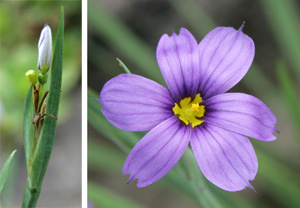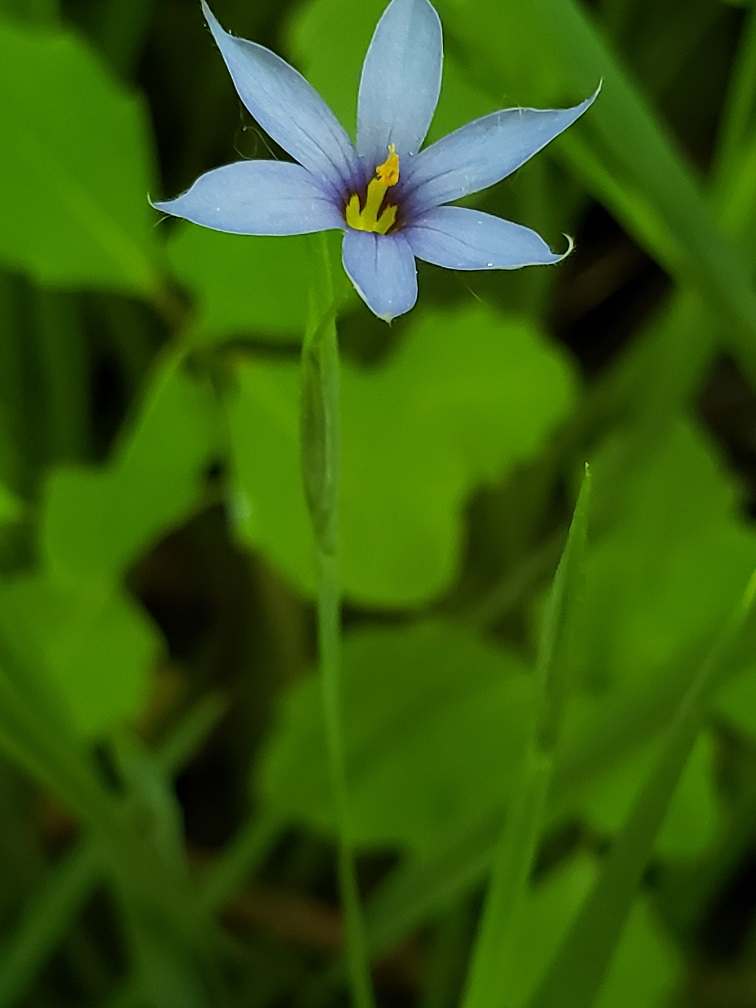This week, I’m featuring Common Blue-eyed Grass (Sisyrinchium montanum) as one of our local wildflowers that begins to bloom at this time.


Common Blue-eyed Grass is actually a member of the iris family (family Iridaceae), which consists of herbs growing from rhizomes, bulbs, or corms, with narrow basal leaves and showy flower clusters at the tips of long stalks.
Description:
Common Blue-eyed Grass is a native North American perennial with a clump-forming growth habit and narrow blade-shaped leaves. Leaves are all basal, long and slender, grass-like, generally 5-10 inches long, the largest over 1/10 inch wide with smooth, almost waxy surfaces and very finely toothed edges. The flowering stems are also flattened, 1/10 to 1/8 inch wide, with a strong central vein and two distinct wings on the sides. The stem also has very finely toothed edges and often twists up to a full turn from base to tip.

Its star-like flowers are bright blue to deep violet with a yellow center, 5/8 to ¾ inch across with 6 tepals (three petals and three almost identical sepals, although the sepals are typically slightly wider than the petals – see photo below), the tips of which are usually notched with a small needle-like projection at its very tip.

A bright spot at the base of each tepal creates a greenish to yellow throat, with a column of bright yellow-tipped stamens in the center. Flowers or borne in groups of 2 to 4 on short slender stalks with only 1 or 2 flowers open at a time, at the tip of a long leaf stem and enclosed by two narrow leaf-like bracts (spathe); flowers are overtopped by a pointed bract (see first photo below). The spathe (see second photo below) is typically green like the color of the leaves and stem, sometimes bronze or purplish, with the outer one up to 3 inches long and may be more than twice as long as the inner one. The edges of the outer spathe are joined for up to 1/8 inch at the base.


https://www.minnesotawildflowers.info/flower/mountain-blue-eyed-grass#lboxg-2
The fruit is a round to oval capsule between 1/8 and ¼ inch long, on a slender stalk and divided into three sections (carpels), containing tiny black seeds.

https://www.minnesotawildflowers.info/flower/mountain-blue-eyed-grass#lboxg-4
Culinary and Medicinal Uses:
No known uses as food.
American Indian tribes used the roots of Common Blue-eyed Grass to make a tea for treating diarrhea (especially in children), to cure stomachaches, and to expel intestinal worms. Herbalists have used these teas to treat menstrual disorders, for birth control, and as a laxative.
Wildlife Value:
The floral rewards of Common Blue-eyed Grass attract bee flies, bumble bees (including Brown-belted Bumble Bee (Bombus griseocollis), Half-black Bumble Bee (Bombus vagans), Red-belted Bumble Bee (Bombus rufocinctus), and Yellow Bumble Bee (Bombus fervidus)), Halictid bees, sweat bees, and Syrphid flies.
Northern Cardinal (Cardinalis cardinalis), Song Sparrow (Melospiza melodia), Wild Turkey (Meleagris gallopavo) eat the seeds.
Where Found Locally:
Common Blue-eyed Grass can be found in moist fields, meadows, open shorelines, forest edges, and open woods.
- 100 Acre Wood
- Ann Lee Pond Nature and Historic Preserve
- Balsam Way Natural Area
- Bauer Environmental Park
- Community Connector Trail
- Dwaas Kill Nature Preserve
- Fox Preserve
- Garnsey Park
- Hayes Nature Park
- Historic Champlain Canalway Trail
- Mohawk Hudson Bike-Hike Trail
- Mohawk Landing Nature Preserve
- North Woods Nature Preserve
- Settlers Hill Natural Area
- Summer Hill Natural Area
- Swatling Falls Nature Trails
- Town Park
- Ushers Road State Forest
- Veterans Bike Path
- Veterans Memorial Park
- Vischer Ferry Nature and Historic Preserve
- West Sky Natural Area
- Woodcock Preserve
- Zim Smith Trail













































